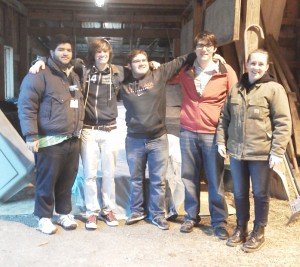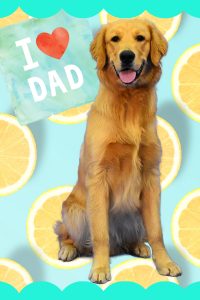RPI Alpha Phi Omega Students help TASP Staff Tag Sale Fund Raiser


Students from Rensselaer Polytechnic Institute’s Acacia Fraternity provided the manpower this month, helping The Animal Support Project (TASP) erect a secure 2,000 square foot outdoor canine training yard. The yard, constructed primarily from welded steel kennel panels obtained through a grant from The American Society for The Prevention of Cruelty to Animals (ASPCA), will be used for humanely treating behavior in TASP program dogs through positive training and controlled behavior modification methods.
According to TASP President, Melinda Plasse, “TASP’s experience with companion animal crisis intervention indicates that problem behavior is a huge contributor to canine surrenders and euthanasia. We don’t expect to create lambs out of lions here, but of those who do have the potential, we intend to create clearer-thinking, more manageable pets who will have developed the emotional skills to live successful lives in the community. We are thrilled to have the Acacia Brothers onboard for this project, and we look forward to their further involvement during the actual operation of the yard.”
The ASPCA grant was awarded as part of a continuing commitment to Brooke, a dog rescued by TASP from ASPCA’s Hurricane Sandy Temporary Emergency Boarding Facility in Brooklyn, NY. In addition to Brooke, the training yard will offer a legacy of support to TASP program dogs needing behavioral adjustment in order to adapt to home and family life. ASPCA Behaviorists and Crawmer’s Animal Training of West Sand Lake, NY, will provide guidance to TASP volunteers operating the yard program.
For the full Press Release, please visit… http://www.theanimalsupportproject.com/?p=662

Right now, many folks are reading this message while still in isolation or quarantine or curfew. You may be wondering how The Animal Support Project will be dealing with the changes in all of our lives brought about by the arrival of the Novel Corona Virus and the Random Acts of Crime occurring here in the Capital region and throughout the state. Like everyone else, TASP faces some challenges ahead. We face a loss of revenue from having to temporarily call off our popular Fantasy Pet Photo fund raisers and our tag sales. Add to this an already-evidenced reduction in donations due to the financial stresses many of our supporters are facing after the State imposed mandatory shutdown of so many businesses in NY and then “vampires” decided to destroy what was left of local businesses. These are realities we can’t get around.
That being said, TASP is morphing to adapt as well as we can to continue offering the most support we can muster with available resources. For now, all personal visits to homes have been postponed. We’ve also had to curtail our activities in the local cities after dark due to curfew and the potential risk to our volunteers. That means no adoption home visits, no visits inside the homes of ailing pets. This is the way it has to be in order to reduce risk of infection or injury to our volunteers and our community. By coincidence, our list of adoptable pets is very small right now and their continued care at their foster homes is perfectly alright until the situation eases. And just because we can’t enter a pet’s home doesn’t mean we can’t help pets who need us. As long as our budget allows, we will utilize all available technologies like video, photos, messaging and facetime to confirm financial need and explore the situations of individual pets so they can be directed to whatever proper professional care we can afford. We can also use video and photos to demonstrate and instruct on preventive care practices to help our community’s pet guardians do the best they can for their best friends.
Our ability to pay for professional veterinary procedures at this time is very much in flux with funds temporarily dried up, but TASP is actively seeking grants for worthy purposes like veterinary care and continuation of our Paws2Protect program that provides free Seresto flea & tick collars to financially needy dogs and cats. We also have expanded our pet food pantry stocking program to serve TEN food pantries across Albany, Rensselaer, Washington and Bennington counties. The Paws2Protect and Hoss Fund programs continue to serve as long as resources remain available and if one of our already-submitted grants is awarded to TASP, we will introduce yet another great program to our toolkit, The Vintage Club: offering vital veterinary services specifically for senior pets.
We’ve even found a way we can still run our Fantasy Photo EASTER CLINICS completely online, with an option for a mailed hard copy photo. So if you’d like an Easter/Spring theme photo of your best friend, just scroll down and click for the lowdown on how to make it happen. We’ve posted details of this new fund raising scheme with sample backgrounds right here on the TASP website, taking orders online and accepting payment through Paypal or by check. Depending on how the reopening of NY State proceeds, we may be holiding our photo clinics online for a few more months so stay tuned!
COVID-19 is an unprecedented pandemic situation that virtually every American jurisdiction knew would occur someday. Even so, it would have been financial and logistical folly for any nation to stockpile the number of devices and supplies needed for this scale of a disaster for the 102 years since the last great epidemic, the Spanish Influenza of 1918. The incident command system shared by local, state and federal agencies as well as 1st responders, businesses, nonprofits and institutions across our nation is the modular, scalable method for efficiently and accountably answering the challenges ahead that COVID presents. TASP will do our best to add our compassion, skills, experience and elbow grease to this response to prevent the suffering of our community’s animals. It’s what TASP is trained to do and we’re up to the task.
We wish all of you reading this a safe and healthy path forward. Please be kind, be brave, be objective and be smart. We WILL get through this and we will bring our animal companions with us to a wiser, kinder world.
Concierto
Concierto stood by the round bail feeder,
withered and wet, spring mud clinging to his hocks
ribs protruding hard and knobby
like the exposed roots of a stricken tree.
“I think it’s cancer,” Aunt Mary said.
“he’s lost three hundred pounds this week”
I nodded and stepped up
reached out a pale hand and scratched
the center of his neck through the fence
for the thousandth time.
He rolled back his muddied eyes,
tilted and lifted back his head.
I stepped closer to him
smelled his neck and mane
and he rested his chin on the crown of
my head.
He gently moved his muzzle to my shoulder
and I ran my hands over his nostrils and
lips, still soft and velvet as the day he was born,
and rubbed the white star between his eyes.
“Happy Easter, old man.” I whispered.
I took his chin in my hands and
kissed him below the forelock.
pulled out my phone
captured a final portrait
of a proud warmblood
and watched him in the mirror as I drove away.
He returned to the feeder,
buried his nose in the hay all
headed out, pale-green and perfect
his jaw still strong,
his methodical chewing
a reassuring reminder
that horses live and love
unburdened and
ever present.
When the Vet tells you they’re going to do some bloodwork, what does that really mean? We all know it means a tech will probably come into the room and hold your pet steady while the vet draws one or more syringes worth of blood from the animal’s vein. It may be taken from a front or a rear leg, depending on the pet’s size and disposition and the quality of the veins.
But what happens after that blood leaves the exam room? What kinds of tests can be done on blood and how do we know why certain tests are necessary? And how can we learn to interpret blood test results ourselves, so we can better understand our pet’s condition and participate more effectively in treatment when it’s required?
One of the most common and most essential blood tests done on dogs is the 4DX snap test. That’s slang for a chemical test done with a plastic disposable device that has a bit of fresh blood applied to it. The 4DX tests for four different conditions that are now common in our region: Heartworm, Lyme Disease, Anaplasmosis and Ehrlichia. The last three in that list are tick-borne viruses; they result from the injection of tick saliva into the animal’s bloodstream. Heartworm is spread by a bite from a mosquito.
Caught early, all the tick-borne diseases discovered by a 4DX can be treated by antibiotics and brought under control. If these viruses are not caught early and treated, serious disability, organ damage and even death can follow. Heartworm caught early can also be treated effectively, but it is a much more involved treatment and far more costly than treating the tick-borne viruses. The bottom line: a simple 4DX test every year or two saves money and lives.
When it comes to blood tests common to most species, we need to think about the CBC and the Blood Chemistry tests. These are the tests that help a vet determine what may be happening inside the animal. After all, a vet is at a disadvantage in attempting to uncover the cause for your pet’s overt symptoms. If Fluffy is suffering from chronic diarrhea, or is lethargic, or urinating rainbow colors, she can’t tell us verbally that she drank from a stinky puddle this morning or has been infected by a parasite. But conditions like anemia, infection, inflammation, dehydration, cancer, immune-mediated disease, kidney and liver deficiencies are all signaled by the blood. A blood test is a snapshot in time of the animal’s internal chemistry. It may need to be run more than once over time to reveal trends in recovery or decline of the animal’s condition. And sometimes follow-on testing needs to be done to further describe a condition; but it’s the CBC and Blood Chemistry panels that are the first-line detectives.
There are five parameters the vet is evaluating in the CBC & Chemistry: red blood cells, white blood cells, serum (AKA plasma), fibrinogen, and platelets. The results will usually show two columns or graphics: one lists your pet’s level for each parameter, the second lists the normal ranges for those parameters so you can compare your pet’s results with what we consider normal. Here’s a crash course in what the results of each parameter can mean:
Red Blood Cells: too many of these is typically associated with dehydration; too few usually means anemia. Red blood cell shape and size also can tell a vet about underlying conditions that may be at work in your pet, and some parasites can also be detected in the red blood cells.
White blood cells: too many? Infection likely; too few? Auto-immune disease possibility. The shape of white blood cells can signal certain blood cancers as well.
Platelets: Too few platelets can indicate presence of a tick-borne virus like anaplasmosis or ehrlichia or an auto-immune disease like immune mediated hemolytic anemia (IMHA).
Fibrinogen: Elevated levels indicate infection or inflammation.
Serum/Plasma: Altered levels can indicate kidney or liver damage, metabolic abnormalities, or tissue damage. Changes in electrolytes, glucose, proteins, bilirubin, enzymes, BUN (blood urea nitrogen) and creatinine are all measured and compared to what are considered the normal levels.
Of course, this is just a “Ten Cent Tour” version of the meaning of bloodwork. Your vet has many years of schooling and practice under their belt. They use their knowledge and experience to interpret the subtle chemical interactions represented by your pet’s blood test results. They also combine these test results with the animal’s history, appearance and behavior, and possibly even other tests like X-Rays and urinalysis, in order to diagnose your pet’s condition. But hopefully, armed with this basic explanation of the components of a blood test, you will be able to more effectively communicate with your vet to obtain the best possible outcome for the pet who’s depending on you.
Don’t hesitate to ask your vet to show you your pet’s blood test results on paper. And make sure they help you understand any of your pet’s blood test results that come through outside the normal ranges. A good vet wants their client to understand their pet’s condition so they can be an effective partner in treating the patient’s condition. They know it’s the pet’s owner who will be responsible for administering meds and tracking changes in the pet’s appearance and behavior once the appointment is over. This is best done with a basic understanding of the underlying mechanisms bloodwork can detect and describe. So ask questions. Take notes. You’re part of a team dedicated to healing an animal that can’t speak for itself.
Remember these two ladies from our last newsletter? That was Puppy and Gail back in 2017. Back then, Puppy was keeping Gail’s spirits up after Gail lost her husband and her son. The two were inseparable and TASP made sure Puppy received the care she needed to remain healthy. After all, she had an important job to do as Mom’s primary companion.
It was a rough winter for Gail and Puppy. Gail’s health continued to fade and the little mobile home suffered from frozen pipes and way more snow than Gail could deal with. Meantime, Puppy needed occasional modification of her heart meds to keep her coughing under control. Over the long winter, Gail made a couple of emergency trips to the hospital for her breathing problems and ultimately, her invitation to heaven came. She reluctantly left Puppy and went to be reunited with her son and husband, her beloved goats and all the others who left this world before her. That left Puppy alone for the first time in her life.
Before Gail was loaded into the ambulance for her last trip to the hospital, she gave her house keys to a kind neighbor and asked her to watch over Puppy and to call TASP if she didn’t return. It was the neighbor who notified us of Gail’s passing and Puppy’s new status. The next day, a TASP volunteer visited Puppy and taught the neighbor all about the medicines Puppy took three times each day. For the next few days, this good neighbor visited Puppy regularly, feeding & medicating her, running the TV and keeping the little dog company until Gail’s daughter could arrive from Florida.
What a wonderful moment for Puppy when Sis walked in the door! She remembered Sis from the old days, and what’s more, Sis has the same distinctive voice as Gail! After what seemed like the loneliest time in Puppy’s little life, being gathered up into Sis’s arms and hearing her voice made the world seem beautiful again. A new chapter had begun!
Again, the TASP volunteer visited Puppy’s home, this time to meet with Sis and teach her how to administer Puppy’s meds. TASP provided a month’s supply of meds and a spreadsheet listing each medication, dosage and other important information for Puppy’s future care.
Over the next days, Sis closed up the little old mobile home and took care of Gail’s final business; and then she and Puppy left for Sis’s home in Florida. Puppy flew with Sis right in the cabin, as a VIP comfort dog, and she made it through the flight like a real pro. Now, little Puppy lives the pampered life and travels everywhere with Sis in the land of sunshine. She has a human family, a cat and other dogs to cuddle with and the warmer climate and more active lifestyle have done wonders for her heart & lungs.
Puppy knows that someday she’ll receive her invitation to heaven and will eventually get to be with her Mama, Pop and Bro again. But for now, she’s enjoying the benefits of her new life and family. It feels good to know Puppy remains loved and is getting the excellent care she deserves. As Gail’s loyal little companion, she gave her all. Now it’s all coming back to her in spades!
Pet Connection Adoption Day At the Animal Hospital
Sponsored by Healthy Pet Center
What an incredible success for the animals! This year, TASP added a new feature to our big white tent: Kitty City! Seven beautiful local cats displayed their charms for the public, and ALL SEVEN were adopted to terrific homes! Couldn’t have done this without the help of our treasured volunteers and of course, none of this would have been possible without the opportunity provided by Steve Caporizzo’s Pet Connection, Healthy Pet and The Animal Hospital. In spite of the heat, the event management made sure humans and animals alike were all safe and comfortable. Just an incredibly inspirational day!




Copyright © 2013-2024 | The Animal Support Project Inc.
